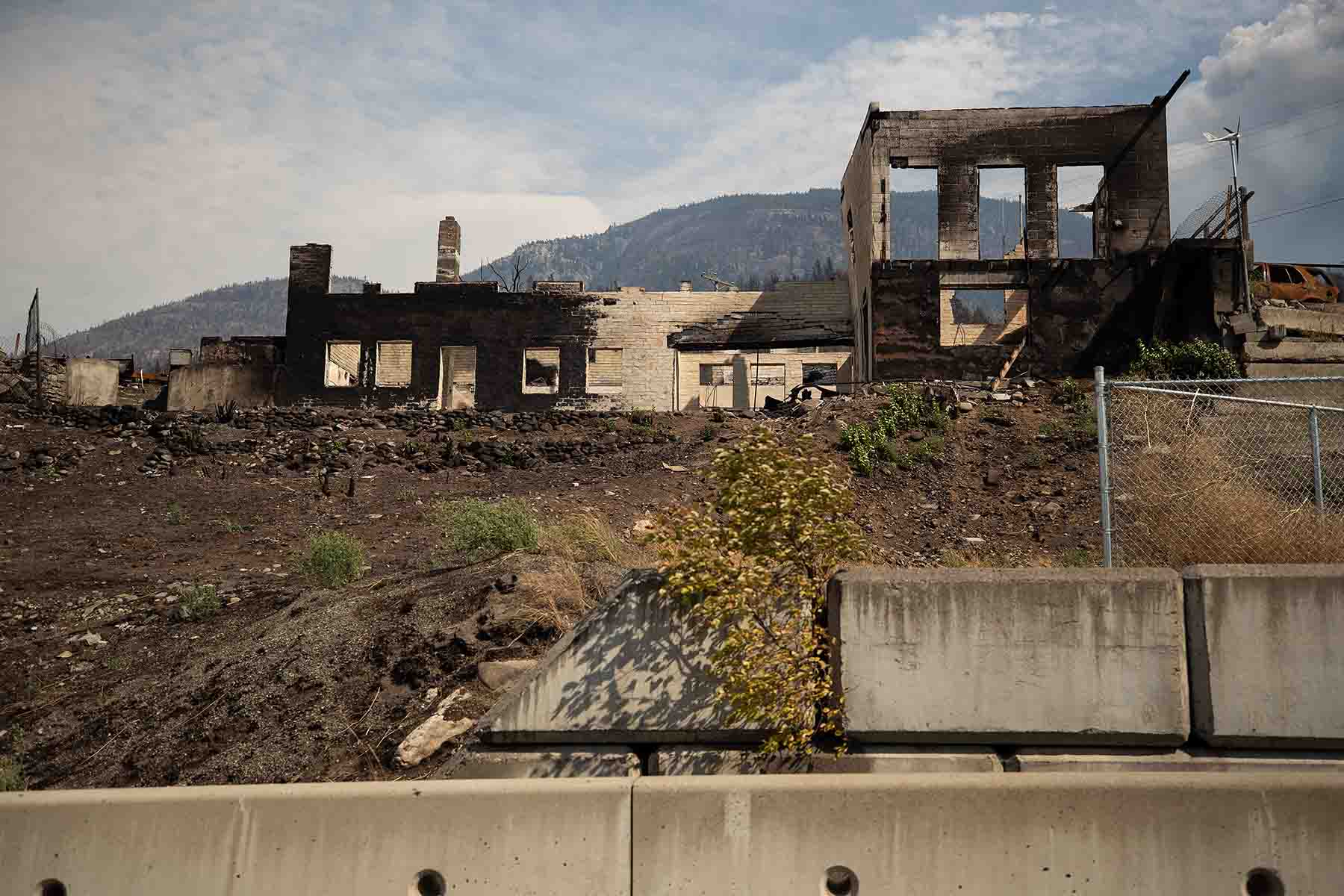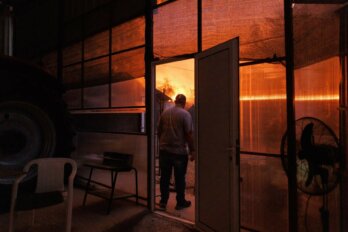“In Canada, there was a town called Lytton. I say was because, on June 30, it burned to the ground.”
—Prime Minister Justin Trudeau in Glasgow, November 2021
British Columbia’s 2021 wildfire season began on June 17, when a fire was reported on George Road, seven kilometres south of Lytton. An Environment Canada warning on June 23 announced that the weather was about to get dangerously hot. Residents were urged to check on friends and neighbours and make sure they stayed cool and were drinking enough water.
Then, on June 27, Lytton, which billed itself as “Canada’s hot spot,” set the country’s all-time maximum high for temperature with a reading of 46.6 degrees, eclipsing the old record of 45 degrees, set on July 5, 1937, at Yellow Grass and Midale, Saskatchewan.
That was hot enough for eighteen-year-old Swedish environmental activist Greta Thunberg to take notice of the tiny Fraser Canyon community from across the ocean. She retweeted a message from meteorologist Scott Duncan, which referenced Lytton’s dubious new record. “It is only June,” Duncan said. “Annual highest temperature is normally in late July!” Thunberg warned: “The heat-wave is just getting started.”
Unfortunately, they were right. Less than twenty-four hours later, on June 28, Lytton smashed its new record with a reading of 47.9 degrees, and it was far from finished making news. On June 29, the temperature hit 49.6 degrees. Lytton’s old record for that day was 40 degrees, set in 2008. And its brand new all-time record was already obsolete, by a margin of nearly two degrees.
A bulletin sent out by Environment Canada that day at 4:26 p.m. warned: “A dangerous long-duration heat wave is affecting BC. Threat: Daytime highs ranging from 40 to 48 degrees Celsius combined with overnight lows of 18 to 24 degrees Celsius. . . . There is little relief at night with elevated overnight temperatures. This record-breaking heat event will increase the potential for heat-related illnesses and increase the risk of wildfires due to drought conditions.”
Lytton was shockingly, dangerously hot. On Wednesday, June 30, Environment Canada noted: “Yesterday’s record at 49.6 C set a new world record of the highest temperature ever recorded above latitude 45 N, beating the previous record of 49.4 C (121F) set in Steele, North Dakota in July 1936.” The forty-fifth parallel passes through the Piedmont region of Italy, just south of Turin, and along the Quebec–Vermont border. “The official highest recorded temperature [anywhere] is now 56.7 C (134F), which was measured on 10 July 1913 at Greenland Ranch, Death Valley, California, USA.”
About half an hour before Environment Canada sent out that bulletin, flames had shot into the home of seventy-four-year-old Eric Siwik, engulfing it within seconds. Siwik hid outside behind a large metal rubbish bin. There was nowhere safe to go. Thick smoke blocked his sight and made it tough to breathe. He thought he was about to die before paramedics rescued him. Downtown, Lytton’s RCMP station exploded in flames.
I was in my backyard in Metcalfe, Ontario, just outside Ottawa, with my wife, and we were planning our annual summer trip to Lytton. We go back every summer to fish and put on a play based on our creation stories for the community with my theatre company and our ensemble of families and children. I opened my phone to check Facebook when I saw a livestream of Lytton on fire. Someone from across the river was livestreaming the whole thing. I ran to my computer and watched in horror as my childhood home burned in real time. My mom’s house and the houses of my friends and relatives all catching fire. The wind was blowing the flames horizontally. Cars exploding, houses exploding. I saw my brother’s work van ignite and then explode in my mom’s backyard. I didn’t know if anyone was home or where any of my family was. I didn’t know if they made it out. And then the thick black smoke obscured everything. And I knew that if anyone was in town, they wouldn’t be able to survive that. I felt like I was burning. Like I was on fire. And there was nothing I could do.
—Kevin Loring
Tricia Thorpe and her husband, Donny Glasgow, a school bus driver, felt their home was safe, a few kilometres away in Botanie Valley, and drove into Lytton to help their friends and neighbours. All they could see was smoke. The fire had jumped the Thompson River. The entire village was in flames, from one end to the other. Behind them, a ridge of flames was consuming their house and barn. While they were trying to help, they lost everything—even their observatory, atop the barn, which was outfitted with an $1,800 Russian telescope so that Donny could see Venus and star clusters and other spots light years away. The flames swallowed up their newly completed workshop, chicken coops, gardens, $35,000 worth of spinning wheels and a loom, and their pets and livestock, including alpacas, sheep, peacocks, chickens, a Great Pyrenees dog named Thunder, and two puppies. Donny’s wallet and identification were also gone. The rest of Thunder’s litter and their mother, Sunshine, were rescued, along with a particularly tough cat. All of it hurt, but losing the animals was the worst.
Something massive and global was happening. The Lytton inferno was among more than 200 active fires burning across BC. Meanwhile, in Europe, the climate change problem wasn’t so much fire as flooding, which killed more than 200 people in Germany, Belgium, and neighbouring countries throughout July. Lytton had a long history of fires, but nothing like this. The picturesque little town in the mountains was suddenly a poster child for global climate disruptions.
A report from the Latin American news agency CE Noticias Financieras began: “The heat wave in the northern hemisphere is breaking records in 2021. A clear example of this is the case of Lytton . . . which recorded in early July the highest temperature in history in the country at 49.5°C. That sparked wildfires that engulfed the town in flames and its 250 inhabitants had to flee for their lives. Less dramatic but no less troubling news is repeated throughout the west coast of North America in the face of the alarmingly high temperatures recorded since the beginning of the boreal summer.” The report went on to note that the planet has warmed by about 1.2 degrees since the industrial era began, and scientists are warning that things will get hotter—and worse—unless dramatic changes are made to cut CO2 emissions.
“It’s dire,” Thunberg tweeted, quoting Lytton’s mayor, Jan Polderman. “The whole town is on fire. It took, like, a whole 15 minutes from the first sign of smoke to, all of a sudden, there being fire everywhere.”
Lost to flames that day were 124 structures in the village of Lytton and forty-five in the adjacent Lytton First Nation, as well as thirty-four nearby rural properties. That meant 90 percent of local buildings had been ruined in a flash. Most of those properties, including that of Glasgow and Thorpe, were either uninsured or underinsured, as it was tough to get coverage in such a hot, dry location with no full-time fire department.
The destruction included the village hall and official records. Gone also were Lytton’s two grocery stores, the farmers’ market, pharmacy, bank, medical centre, coffee shop, and outdoor benches. The day after the fire, the BC SPCA was allowed to enter the village for four hours to rescue forty-one animals.
A week after the fire, Prime Minister Trudeau met with Mayor Polderman, Janet Webster, chief of Lytton First Nation, and chair of the Nlha7kápmx Nation Tribal Council, Chief Matt Pasco, hours away in Coquitlam to talk about how the community might recover. By that time, Lytton’s now-former residents were harbouring strong suspicions that the fire wouldn’t have spread so fast if grass and bushes hadn’t been allowed to grow so close to the railway tracks. Dry as it was, the vegetation was just kindling waiting for a spark. The trains and the scalding hot metal rails threw off plenty of those.
An image captured by the engine camera of the Canadian Pacific coal train that passed through Lytton at approximately 4:30 p.m. was posted on the Transportation Safety Board’s website as part of a report on their investigation into the possibly train-related origins of the fire. The photo shows tinder-dry brush all along the edge of the track. Also in the image, a young mother, identified as KR, is seen standing beside the track, with her young child, on the path leading to the walkway across the bridge. As the train passes, KR and her child are covered in coal dust from the train. She films the train with her phone as it passes.
Afterward, KR walked across the bridge to her home on the west side. Halfway across the bridge, at approximately 4:45, she noticed a fire had started at the edge of the track, so she called the fire department. By the time she was across the bridge, people were arriving and trying to put out the flames, but the fire spread rapidly uphill and along the banks of the railroad. At the time, the wind was blowing at around thirty-five kilometres per hour, with gusts up to fifty kilometres per hour. As the fire drew in the extremely dry canyon air, the winds suddenly reached upward of seventy-five kilometres an hour, with gusts reaching hurricane force. Within minutes, Lytton was engulfed in flames.
Warren Brown, a water technician for Lytton First Nation, was one of the brave locals helping to battle the blaze alongside the Lytton Volunteer Fire Department. When the fire knocked out the power to the water system feeding the hydrants, Warren was able to fill two of the seven systems by redirecting a local creek. “We were thinking, just get the hydrants up and running for the firefighters.” Residents ran for their lives with nothing but the clothes on their backs. The volunteer firefighters fought for as long as they could, but it wasn’t long before they had to evacuate as well.
Jeff Chapman was visiting with his parents, Jeanette and Michael, when they noticed smoke down at Hobo Hollow. What they thought was a grass fire quickly spread to their yard. They tried to put out the flames, but within ten minutes, their house was on fire. Michael and Jeanette sought shelter in a trench on their property, and as Jeff was overwhelmed by the speed of the fire, he ran down the train tracks. He filmed himself as he ran for his life. In the video, the town burns around him, the footage capturing the shock and horror of the fire. Jeff made it out alive, but tragically, his parents were the two fatalities of the fire.
The TSB’s investigation found no “anomalous” indicators on the train itself that would indicate an ignition source. However, the investigator in charge, James Carmichael, speaking at a streamed media information session after the report’s release, stated that the TSB’s investigators believed the Lytton fire originated “within five feet” of the centre of the track. Train cars are typically ten feet wide.
The year before the Lytton fire, Canadian National Railway had paid a $16 million penalty for starting a wildfire ten kilometres down the line a few years earlier. On June 11, 2015, the Cisco Road fire was started by workers cutting a rail. It burned 2,400 hectares and took four months to extinguish. In 2016, another fire was ignited by the railroad near Spapium, on the west side of the Fraser River near Nikaia Creek. Structures were burnt, and an evacuation was ordered for Lytton and surrounding areas. So folks were familiar with the dangers of dry summer heat and trains, but nothing could prepare them for the ferocity they would face on June 30, 2021.
The Lytton fire burned until August and destroyed 83,000 hectares. The CNR Thompson Bridge at Lytton was extensively damaged, shutting down rail traffic along that critical line. The CP railroad was still intact, so traffic along that line continued. The pace of trains through the canyon slowed temporarily, but the rail lines are economic arteries to the Pacific. The wealth of the nation passes in and out of the Fraser Canyon every day. By July 13, the CNR had repaired the Thompson Bridge, and rail traffic resumed.
Residents and journalists were allowed to tour what remained. They saw the grey ruins of houses, and trucks with melted wheels. The post office and a church still stood. So did the memorial to Chief Cexpe’nthlEm. The brightly coloured rainbow crosswalk, optimistically painted in June 2019, also somehow remained. It had been painted to honour the local 2SLGBTQ+ community on the suggestion of Lytton RCMP commander Sergeant Curtis Davis, and the local high school had agreed to pay for the paint. Tangled power lines lay on the ground.
The heat warnings hadn’t let up. On July 5, a warning let people in the area know their troubles weren’t over: “A dangerous long-duration heat wave continues with elevated overnight lows.” The latest heat warning finally ended on July 7, when Fraser Canyon residents were warned of a new weather-related threat: “Thunderstorms are expected to be short-lived but have the potential to produce pea to nickel size hail and 5 to 15 mm of rain. . . . Severe thunderstorm watches are issued when atmospheric conditions are favourable for the development of thunderstorms that could produce one or more of the following: large hail, damaging winds, torrential rainfall.” Heat warnings continued to pop up until July 16, cautioning: “Above seasonal daytime temperatures and elevated overnight temperatures will mean little relief from the heat.”
The long-range forecast from Environment Canada was frightening: “Over the next 30 years, the number of extremely hot days in a year is expected to more than double in some parts of Canada.”
Tiny Lytton was referenced by Trudeau in his opening statement to the Conference of the Parties to the UN Climate Convention in November 2021 in Glasgow, Scotland, before 120 world leaders. “In Canada, there was a town called Lytton. I say was because, on June 30, it burned to the ground,” Trudeau said. “What happened in Lytton can and has and will happen anywhere. How many more signs do we need? This is our time to step up—and step up together.”
Then Trudeau committed to cap emissions from Canada’s oil and gas sector. “We’ll cap oil and gas sector emissions today and ensure they decrease tomorrow at a pace and scale needed to reach net zero by 2050,” he declared. “That’s no small task for a major oil and gas producing country. It’s a big step that’s absolutely necessary.”
Thunberg was at the meeting. She wasn’t impressed by the earnest words of the world leaders. Instead, she sang, “You can shove your climate crisis up your arse,” outside the meeting. Then she told supporters, “We say, ‘No more blah, blah, blah. No more exploitation of people and nature and the planet.’”
Meanwhile, the people of Lytton, wherever they were staying, were taking a different angle on outrage. They didn’t want to be referred to in the past tense.
The smell of the seasons in the canyon, the wind, the rivers, the mountains. The sound of the coyotes howling on the west side on cold winter nights. The rhythm of the trains rumbling by. The big trucks buzzing by on the Trans-Canada Highway. I played here, learned here, loved here. My history is here, on these streets, buried in this ground.
You dig anywhere in this town and you’ll find artifacts from thousands of years of Nlaka’pamux. Now this charred layer that was the Lytton of my entire life is just another layer in the geography, and the Lytton I remember a slowly fading hologram in my mind.
—Kevin Loring
Excerpted, with permission of Random House Canada, from Lytton: Climate Change, Colonialism, and Life before the Fire by Peter Edwards and Kevin Loring. Copyright © Peter Edwards and Kevin Loring 2024. All rights reserved. No part of this excerpt may be reproduced or reprinted without permission in writing from the publisher.



